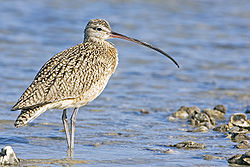- Curlew
-
For other uses, see Curlew (disambiguation).For other uses of "Numenius", see Numenius.
Curlews 
Long-billed Curlew (Numenius americanus)
Fishing Pier, Goose Island State Park, TexasScientific classification Kingdom: Animalia Phylum: Chordata Class: Aves Order: Charadriiformes Family: Scolopacidae Genus: Numenius
Brisson, 1760Species N. phaeopus
N. tenuirostris
N. arquata
N. americanus
N. madagascariensis
N. minutus
N. borealis
N. tahitiensisSynonyms Palnumenius Miller, 1942
The curlews /ˈkɜrljuːz/, genus Numenius, are a group of eight species of birds, characterised by long, slender, downcurved bills and mottled brown plumage. They are one of the most ancient lineages of scolopacid waders, together with the godwits which look similar but have straight bills.[1] In Europe "curlew" usually refers to one species, the Eurasian Curlew Numenius arquata.
Curlews feed on mud or very soft ground, searching for worms and other invertebrates with their long bills. They will also take crabs and similar items.
Curlews enjoy a world-wide distribution. Most species show strong migratory habits and consequently one or more species can be encountered at different times of the year in Europe, the British Isles, Iberia, Iceland, Africa, Southeast Asia, Siberia, North America, South America and Australasia.
The distribution of curlews has altered considerably in the past hundred years as a result of changing agricultural practices. Reclamation and drainage of marshy fields and moorland, and afforestation of the latter, have led to local decreases, while conversion of forest to grassland in some parts of Scandinavia has led to increases there.[2][clarification needed]
The stone-curlews are not true curlews (family Scolopacidae) but members of the family Burhinidae, which is in the same order Charadriiformes, but only distantly related within that.
Species in taxonomic order
- Whimbrel Numenius phaeopus
- Slender-billed Curlew Numenius tenuirostris - critically endangered, possibly extinct (early 21st century?)
- Eurasian Curlew Numenius arquata
- Long-billed Curlew Numenius americanus
- Far Eastern Curlew Numenius madagascariensis
- Little Curlew Numenius minutus
- Eskimo Curlew Numenius borealis - critically endangered, possibly extinct (early 2000s?)
- Bristle-thighed Curlew Numenius tahitiensis
The Late Eocene (Montmartre Formation, some 35 mya) fossil Limosa gypsorum of France was originally placed in Numenius and may in fact belong there.[3] Apart from that, a Late Pleistocene curlew from San Josecito Cave, Mexico has been described. This fossil was initially placed in a distinct genus, Palnumenius, but was actually a chronospecies or paleosubspecies related to the Long-billed Curlew.[4]
The Upland Sandpiper (Bartramia longicauda) is an odd bird which is the closest relative of the curlews.[1] It is distinguished from them by its yellow legs, long tail, and shorter, less curved bill.
References
- ^ a b Thomas, Gavin H.; Wills, Matthew A. & Székely, Tamás (2004): A supertree approach to shorebird phylogeny. BMC Evol. Biol. 4: 28. doi:10.1186/1471-2148-4-28 PDF fulltext Supplementary Material
- ^ Encyclopedia of the Animal World (1977): Vol.6: 518-519. Bay Books, Sydney.
- ^ Olson, Storrs L. (1985): Section X.D.2.b. Scolopacidae. In: Farner, D.S.; King, J.R. & Parkes, Kenneth C. (eds.): Avian Biology 8: 174-175. Academic Press, New York.
- ^ Arroyo-Cabrales, Joaquín & Johnson, Eileen (2003): Catálogo de los ejemplares tipo procedentes de la Cueva de San Josecito, Nuevo León, México. Revista Mexicana de Ciencias Geológicas 20(1): 79-93. [Spanish with English abstract] PDF fulltext
Further reading
- Bodsworth, Fred (1987). Last of the Curlews. ISBN 0396091873. (originally published in 1954)
Categories:- Curlews
- Numenius
- Genera of birds
Wikimedia Foundation. 2010.
